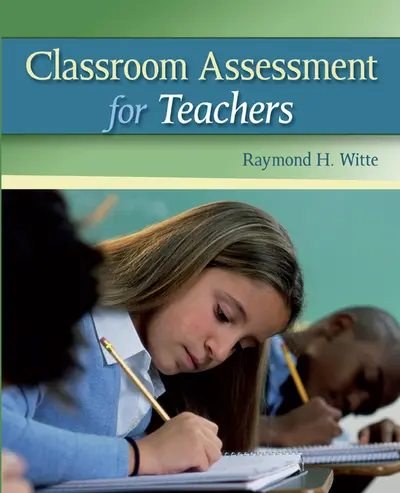My Account Details

ISBN10: 0073378704 | ISBN13: 9780073378701

* The estimated amount of time this product will be on the market is based on a number of factors, including faculty input to instructional design and the prior revision cycle and updates to academic research-which typically results in a revision cycle ranging from every two to four years for this product. Pricing subject to change at any time.
Instructor Information
Quick Actions (Only for Validated Instructor Accounts):
Classroom Assessment for Teachers provides students with essential professional knowledge/skill sets along with contemporary issues surrounding the assessment of student learning progress and achievement. By utilizing an inquiry-oriented approach, pre-service teacher candidates can explore the essential relationship between assessment and teaching with a deliberate focus on encouraging students to construct their own assessment framework and select measures and procedures that are designed to meet their own needs along with those of their students. Individual chapters are devoted to critical assessment topics, including instruction-learning-assessment alignment, formative assessment, self-assessment, formative assessment, grading, Response to Intervention (RTI), performance assessment, affective assessment, as well as high-stakes testing, validity and reliability, and the use of applied statistics in the classroom.
Chapter 1: Teaching, Learning, and AssessmentChapter 2: Elements of the Instruction-Learning-Assessment ModelChapter 3: Academic Standards and Evidence of Student LearningChapter 4: Validity, Reliability, and Avoiding Assessment BiasChapter 5: Formative Assessment: Guiding Student LearningChapter 6: Performance AssessmentChapter 7: Self-Assessment and Progress MonitoringChapter 8: Summative Assessment: Confirming Student AchievementChapter 9: Grading and Student EvaluationChapter 10: Statistics in the ClassroomChapter 11: Standardized Tests and High Stakes TestingChapter 12: Assessment of Students with Identified Learning NeedsChapter 13: Classroom Assessment and Response to Intervention (RTI) Chapter 14: Affective AssessmentChapter 15: Getting Started on the Assessment Path
Chapter 3: Academic Standards and Evidence of Student LearningChapter 4: Validity, Reliability, and Avoiding Assessment BiasChapter 5: Formative Assessment: Guiding Student LearningChapter 6: Performance AssessmentChapter 7: Self-Assessment and Progress MonitoringChapter 8: Summative Assessment: Confirming Student AchievementChapter 9: Grading and Student EvaluationChapter 10: Statistics in the ClassroomChapter 11: Standardized Tests and High Stakes TestingChapter 12: Assessment of Students with Identified Learning NeedsChapter 13: Classroom Assessment and Response to Intervention (RTI) Chapter 14: Affective AssessmentChapter 15: Getting Started on the Assessment Path
Chapter 5: Formative Assessment: Guiding Student LearningChapter 6: Performance AssessmentChapter 7: Self-Assessment and Progress MonitoringChapter 8: Summative Assessment: Confirming Student AchievementChapter 9: Grading and Student EvaluationChapter 10: Statistics in the ClassroomChapter 11: Standardized Tests and High Stakes TestingChapter 12: Assessment of Students with Identified Learning NeedsChapter 13: Classroom Assessment and Response to Intervention (RTI) Chapter 14: Affective AssessmentChapter 15: Getting Started on the Assessment Path
Chapter 7: Self-Assessment and Progress MonitoringChapter 8: Summative Assessment: Confirming Student AchievementChapter 9: Grading and Student EvaluationChapter 10: Statistics in the ClassroomChapter 11: Standardized Tests and High Stakes TestingChapter 12: Assessment of Students with Identified Learning NeedsChapter 13: Classroom Assessment and Response to Intervention (RTI) Chapter 14: Affective AssessmentChapter 15: Getting Started on the Assessment Path
Chapter 9: Grading and Student EvaluationChapter 10: Statistics in the ClassroomChapter 11: Standardized Tests and High Stakes TestingChapter 12: Assessment of Students with Identified Learning NeedsChapter 13: Classroom Assessment and Response to Intervention (RTI) Chapter 14: Affective AssessmentChapter 15: Getting Started on the Assessment Path
Chapter 11: Standardized Tests and High Stakes TestingChapter 12: Assessment of Students with Identified Learning NeedsChapter 13: Classroom Assessment and Response to Intervention (RTI) Chapter 14: Affective AssessmentChapter 15: Getting Started on the Assessment Path
Chapter 13: Classroom Assessment and Response to Intervention (RTI) Chapter 14: Affective AssessmentChapter 15: Getting Started on the Assessment Path
Chapter 15: Getting Started on the Assessment Path
Need support? We're here to help - Get real-world support and resources every step of the way.